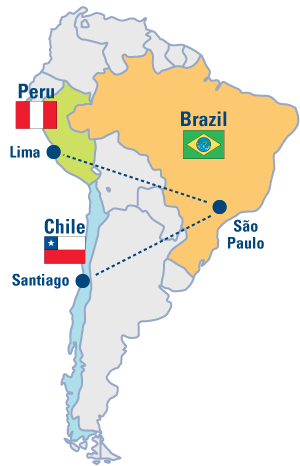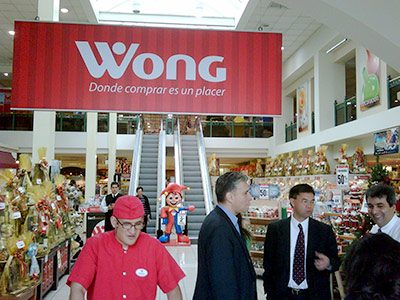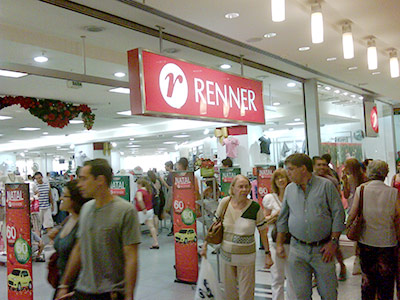Investors Bargain Shopping in Peru, Chile and Brazil
Companies / Sector Analysis Dec 20, 2010 - 03:31 PM GMTBy: Frank_Holmes
 Global Strategist Jacek Dzierwa has just returned from another research trip to Latin America where he visited Peru, Chile and Brazil. Travel is important for our tacit knowledge because many of the world’s best opportunities aren’t discovered behind a Bloomberg terminal or an earnings report. We venture to visit as many companies as possible before investing in them.
Global Strategist Jacek Dzierwa has just returned from another research trip to Latin America where he visited Peru, Chile and Brazil. Travel is important for our tacit knowledge because many of the world’s best opportunities aren’t discovered behind a Bloomberg terminal or an earnings report. We venture to visit as many companies as possible before investing in them.

This was Jacek’s first trip to Peru and the country “surprised to the upside.” Another beneficiary of higher commodity prices, Peru has seen a massive improvement in its standard of living in recent years.

The poverty level has declined from a staggering 55 percent in 2001 to 35 percent this year and is expected to fall to 25 percent by 2015. However, there is still much progress to be made. Roughly 71 percent of Peru’s population works in an informal economy, which means they pay no taxes, have no bank accounts and have no access to credit. The size of this informal economy is second only to Bolivia (80 percent) in Latin America.
Peru’s progress is on display in Lima, the country’s capital and largest city. The bustling metropolitan city is home to South America’s main Pacific port (Port of Callao) and several thousand factories and manufacturing plants. Recent growth has pushed the greater Lima’s population over 9 million people.
One annoying side effect of this progress is heavy traffic. According to some estimates, the number of vehicles in Peru today is five times greater than it was a decade ago. That means that there are now 10 cars vying for space on the same roadways where there used to be two. Numerous Asian manufacturers from Korea and China have been big beneficiaries of this growth in demand for cars.
But there is relief on the way. The Peruvian government recently announced a $24 billion infrastructure overhaul over the next three years that should help the country meet its rapidly growing demand. One beneficiary of this infrastructure spending is likely to be Grana y Montero, a Peru-based construction and engineering company that Jacek uncovered during the trip. The firm is highly profitable with its EBITDA (earnings before interest, taxes, depreciation and amortization) margin in the last three years ranging from 16-20 percent. This is way above average for construction projects where EBITDA margins of 6-8 percent are considered good.

The Wong Family’s Masterpiece
Just like in the U.S., it is the busy season for retail shopping in Latin America. Much of Peru’s retail market is dominated by Chilean-owned companies such as Cencosud, which purchased the popular Wong (pictured) chain of stores back in 2008. The Wong family started the company, which is a supermarket grocery story, in their garage and developed it into a great retail business. Many Chinese emigrated from Macau as laborers in the 19th Century and today Peru boasts a 1 million Chinese population (total country population of 28 million) that has been active in its entrepreneurial efforts such as the Wong family.
In Santiago, Jacek met with Chilean-based large retailers Falabella and Cencosud. Both companies operate at higher profit margins than their U.S. counterparts, which partly explain their current hefty valuations. Cencosud aims to have checkout lines no more than three deep--one outlet Jacek visited had 67 cash registers open and each was busy.
Over in Brazil, Jacek made his third trip to the country in the past 12 months. Unfortunately, Jacek’s experience at São Paulo’s Guarulhos Airport was similar to the one we detailed a year ago—On the Ground in Brazil.
The unconfirmed word on the street is that FIFA has warned Brazil that they need to get their act together and improve the country’s infrastructure before the 2014 World Cup or the games will be moved somewhere else. Just a rumor at this point, but it may be the motivation Brazil needs to get going.
Brazil’s equity market has been a major underperformer this year. One reason is the large number of equity offerings coming out of the country, with the largest being the recent $25 billion offering from state-oil company Petrobras.
Brazil also faces an overvalued currency, which puts exporters at a disadvantage. Jacek snapped this photo as an example of how the overvalued Brazilian real affects retailers. Even after a 60 percent discount, this off-brand shirt costs the equivalent of $43, more than what one would pay in the U.S. for some name brands.

Inside Brazil’s Retail Sector
On the other hand, Brazilian retailers that sell a wide variety of imported goods can benefit from a stronger currency. In particular, we’re optimistic about Lojas Renner (pictured).

Renner seeks feedback from customers before they leave the store
Renner, which is similar to a Macy’s in the U.S., has developed a cutting-edge “Enchantment” policy that asks each customer to take a satisfaction survey before they leave the store. Customers do so by pressing a simple button labeled unsatisfied, satisfied or enchanted. If a customer chooses unsatisfied, an associate immediately engages them to correct their experience.
In 2009, 16.6 million of the 17.2 million customers surveyed selected either satisfied or enchanted. We think this unique customer feedback loop gives the company a competitive advantage over other retailers.
Another thing to keep an eye on is the proposed integration of the Chile, Peru and Colombia stock exchanges to create a joint equities platform. Known as Mila, the joint exchange is currently in a beta testing phase. If approved, Mila could be the capital creation platform Latin America needs to take the next step in development.
We understand that the integration still requires some issues to be resolved before investors can reap the benefits of a larger trading platform. The companies which stand to benefit the most from a higher profile are those that currently fly under the radar of most investors, particularly those in Peru and Colombia.
For more updates on global investing from Frank and the rest of the U.S. Global Investors team, follow us on Twitter at www.twitter.com/USFunds or like us on Facebook at www.facebook.com/USFunds. You can also watch exclusive videos on what our research overseas has turned up on our YouTube channel at www.youtube.com/USFunds.

Please consider carefully the fund's investment objectives, risks, charges and expenses. For this and other important information, obtain a fund prospectus by visiting www.usfunds.com or by calling 1-800-US-FUNDS (1-800-873-8637). Read it carefully before investing. Distributed by U.S. Global Brokerage, Inc.
Standard deviation is a measure of the dispersion of a set of data from its mean. The more spread apart the data, the higher the deviation. Standard deviation is also known as historical volatility. All opinions expressed and data provided are subject to change without notice. Some of these opinions may not be appropriate to every investor. The S&P 500 Stock Index is a widely recognized capitalization-weighted index of 500 common stock prices in U.S. companies. The NYSE Arca Gold BUGS (Basket of Unhedged Gold Stocks) Index (HUI) is a modified equal dollar weighted index of companies involved in gold mining. The HUI Index was designed to provide significant exposure to near term movements in gold prices by including companies that do not hedge their gold production beyond 1.5 years. The MSCI Emerging Markets Index is a free float-adjusted market capitalization index that is designed to measure equity market performance in the global emerging markets. The U.S. Trade Weighted Dollar Index provides a general indication of the international value of the U.S. dollar.
Frank Holmes Archive |
© 2005-2022 http://www.MarketOracle.co.uk - The Market Oracle is a FREE Daily Financial Markets Analysis & Forecasting online publication.



